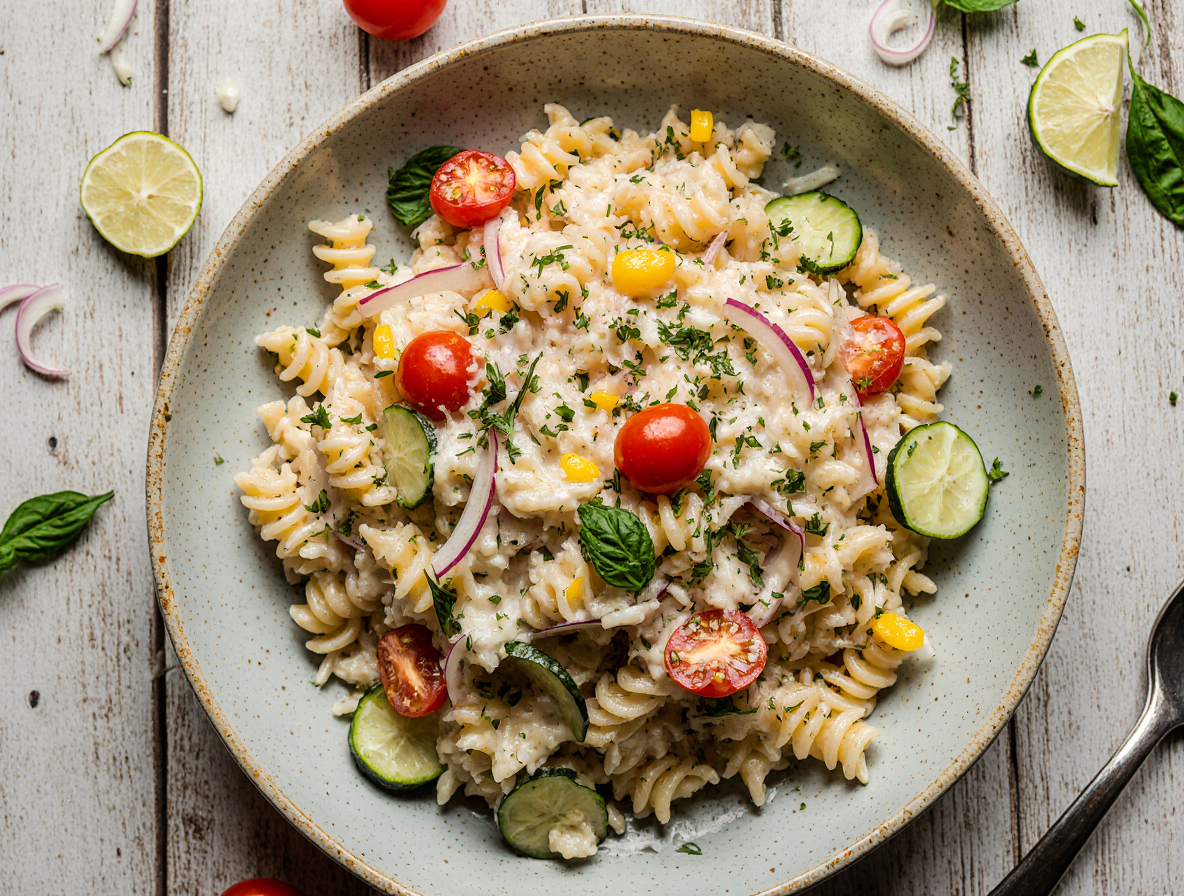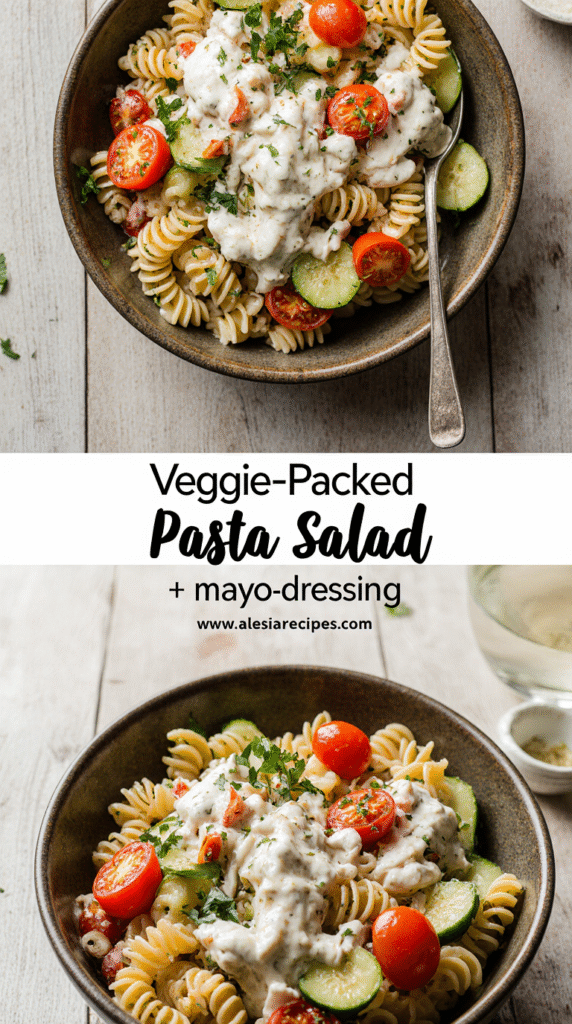How to Make the Best Vegetable Pasta Salad with Mayonnaise (Easy 15-Min Recipe)
Did you know you can whip up a delicious vegetable pasta salad with mayonnaise in just 15-20 minutes?
This versatile dish is my go-to summer recipe that never disappoints. Whether I’m hosting a backyard barbecue or attending a family picnic, this creamy pasta salad with mayo always earns rave reviews. Not only is it perfect for Memorial Day and 4th of July celebrations, but it also strikes that ideal balance between creamy dressing and fresh vegetables.
What’s more, this pasta salad with veggies is incredibly adaptable. You can use practically any combination of vegetables you have on hand, making it both convenient and budget-friendly. I often create a 50/50 ratio of pasta to vegetables, resulting in a healthier macaroni salad with vegetables that doesn’t sacrifice flavor.
Additionally, this veggie macaroni salad offers a delightful mix of creamy, tangy, and crisp textures that complement any summer meal. In this article, I’ll share my foolproof method for creating the perfect pasta salad dressing with mayo and show you how to assemble a crowd-pleasing dish that’s sure to become your new summer favorite.
Choose the Right Ingredients
The success of any vegetable pasta salad with mayonnaise depends largely on selecting the right ingredients. Choosing complementary components ensures your salad has the perfect balance of textures, flavors, and visual appeal.
Best pasta shapes for creamy salads
For mayo-based pasta salads, the shape of your pasta makes a significant difference. Short pasta shapes work exceptionally well because they’re roughly the same size as mix-ins, making it easier to get a little of everything in each bite. Furthermore, shapes with ridges, holes, or contours trap cheese, vegetables, and dressing, ensuring every forkful is properly dressed.
The most effective options include:
- Twisted shapes like rotini, fusilli, or cavatappi – these have perfect contours for holding onto creamy sauces
- Tube shapes such as penne or elbow macaroni
- Cupped shapes like medium shells or orecchiette – excellent for catching small vegetables like peas or corn
When preparing pasta for salads, cook it just a minute or two past al dente, as it will firm up when chilled. Consequently, rinse cooked pasta under cold water to stop the cooking process immediately and drain thoroughly to prevent clumping.
Fresh vegetables that add crunch and color
The ideal vegetable pasta salad maintains a high ratio of vegetables to pasta – about 50/50 is perfect for both texture and nutrition. Fresh, crunchy vegetables create a delightful contrast against the soft pasta and creamy dressing.
Some excellent vegetables for pasta salad include:
Broccoli florets (slightly blanched), cucumber, bell peppers, cherry tomatoes, red onion, celery, carrots, and black olives. These create a vibrant color palette while providing varied textures from crisp to juicy.
Optional add-ins for extra flavor and protein
To transform your veggie macaroni salad from a side dish into a satisfying main course, consider adding protein-rich ingredients. One cup of chickpeas or white beans adds approximately 14 grams of protein, while shredded rotisserie chicken provides nearly 43 grams per cup.
For cheesy options, crumbled feta, fresh mozzarella pearls, or grated Parmesan (with 28 grams of protein per cup) work beautifully with creamy dressings. Eggs are another excellent addition, with each large egg contributing about 6 grams of protein.
For enhanced flavor, incorporate fresh herbs like basil, dill, or parsley, along with briny elements such as kalamata olives or pepperoncini peppers. These seemingly small additions create depth and dimension in your pasta salad dressing with mayo.
Make the Creamy Mayo Dressing
Creating the perfect creamy dressing is the heart of any delicious vegetable pasta salad with mayonnaise. A well-balanced sauce brings together all the elements while adding rich flavor that complements your carefully chosen pasta and vegetables.
Basic ingredients for pasta salad dressing with mayo
First and foremost, quality mayonnaise serves as the foundation of your pasta salad dressing. I recommend using real mayonnaise rather than substitutes like Miracle Whip, which can be overly sweet. For a standard batch of pasta salad dressing, you’ll need:
- ½ cup mayonnaise – provides creaminess and body
- ¼ cup sour cream – lightens the texture while adding tang
- 1-2 tablespoons vinegar – white wine or apple cider vinegar work beautifully
- 1-2 teaspoons Dijon mustard – adds depth and slight heat
- Seasonings – salt, pepper, garlic powder, and dried herbs like oregano, thyme, and basil
Simply whisk these ingredients together in a large bowl until smooth. The mixture should be creamy yet pourable enough to coat your pasta and vegetables evenly.
How to balance creaminess with tang
The secret to an exceptional pasta salad dressing lies in achieving perfect balance between richness and acidity. Rather than using only mayonnaise, which can make the salad heavy, I combine it with sour cream to lift the flavors.
To create that ideal tangy note, incorporate white wine vinegar or lemon juice. Meanwhile, a small amount of sugar (½-1 teaspoon) counterbalances the acidity. If your dressing tastes flat, try adding a splash of Worcestershire sauce for umami complexity.
The dressing might initially seem strong, especially if you’ve added Dijon mustard, yet this intensity mellows considerably once the salad chills. Moreover, this powerful flavor profile helps the dressing penetrate the pasta, creating a more cohesive dish.
Tips for making it lighter or vegan
For a lighter version, substitute low-fat mayonnaise for regular – the difference in taste is minimal. Alternatively, replace some or all of the sour cream with plain yogurt for a tangier, protein-rich dressing.
Creating a vegan pasta salad dressing is surprisingly simple. Instead of traditional mayo and sour cream, use plant-based alternatives like JUST Mayo and Violife’s Just Like Sour Cream, which closely mimic their conventional counterparts.
For oil-free options, consider replacing mayo with vegetable broth or plain vegan yogurt. To enhance richness without dairy, add a tablespoon of tahini or cashew butter. These substitutions maintain the creamy texture while accommodating dietary preferences.
Assemble the Vegetable Pasta Salad
Properly assembling a vegetable pasta salad with mayonnaise involves specific techniques that enhance both texture and flavor. This crucial step transforms individual ingredients into a cohesive, delicious dish.
Cook and cool the pasta properly
Contrary to popular belief, pasta for cold salads should be cooked beyond al dente—about 2-3 minutes longer than package directions. This prevents the pasta from becoming too firm once chilled, as starch retrogradation naturally occurs during cooling. Once cooked, some chefs recommend against rinsing pasta, though others suggest a quick rinse under cold water to stop cooking.
Mixing in vegetables and beans evenly
In a large bowl, combine your drained beans with the pasta first. Next, add chopped vegetables, distributing everything uniformly. Prior to mixing, ensure all components are similar sizes for balanced bites.
Tossing with dressing while pasta is slightly warm
Perhaps the most valuable tip: add at least half your dressing while pasta is still warm. Heat makes starch molecules swell and become more porous, allowing better flavor absorption. This technique—popular among Italian cooks—creates more flavorful pasta salad than dressing cold pasta.
Letting it rest for better flavor
Afterward, allow your vegetable pasta salad to rest at room temperature for approximately one hour before refrigerating. For optimal results, chill for 3-4 hours or ideally overnight. Just before serving, consider adding remaining dressing for maximum flavor impact.
Customize and Store Your Salad
One advantage of a vegetable pasta salad with mayonnaise is its remarkable versatility. You can transform this dish completely with just a few ingredient swaps.
Variations: Mediterranean, vegan, or protein-packed
For a Mediterranean twist, swap cheddar for feta cheese and add kalamata olives, artichoke hearts, or roasted red peppers. Alternatively, create a caprese-inspired version with fresh mozzarella, basil, and balsamic vinegar instead of white wine vinegar.
To make your pasta salad vegan, simply omit cheese or use dairy-free alternatives. For the dressing, replace mayonnaise with plant-based versions or substitute with a combination of vegetable broth and tahini for richness.
Boost protein content by adding chickpeas, black beans, or edamame – all excellent plant-based options. Alternatively, incorporate grilled chicken, rotisserie chicken, or even hard-boiled eggs.
How to keep pasta salad moist in the fridge
Pasta salad naturally dries out over time. Firstly, coat cooled pasta with olive oil before adding dressing. Secondly, save some dressing separately in the refrigerator, then toss it in just before serving to refresh flavors.
Make-ahead and storage tips
For optimal freshness when preparing ahead, store vegetables and dressed pasta separately until serving time. Generally, vegetable pasta salad remains fresh in an airtight container for 3-5 days, although some chefs recommend consuming within 48 hours for best texture.
Conclusion
Vegetable pasta salad with mayonnaise truly stands as one of the most versatile and crowd-pleasing dishes you can make in just 15 minutes. Throughout this guide, I’ve shared my tried-and-true methods for creating this summer favorite that balances creamy textures with fresh, crisp vegetables.
Remember, the secret lies in selecting the right pasta shapes that capture the dressing, adding plenty of colorful vegetables for that ideal 50/50 ratio, and creating a perfectly balanced mayo dressing that combines creaminess with tangy notes. Additionally, adding the dressing while the pasta remains slightly warm helps it absorb maximum flavor.
This recipe certainly allows endless customization based on your preferences or what’s available in your kitchen. Whether you prefer a Mediterranean version, need a vegan alternative, or want to boost protein content, the basic framework remains adaptable for any occasion.
Most importantly, you now have all the tools to create a delicious vegetable pasta salad that will impress at your next barbecue, picnic, or family gathering. Once you master this basic recipe, you’ll find yourself making it again and again, each time with your own personal touch. Give this easy recipe a try – your summer meals will never be the same again!
FAQs
Q1. What are the essential ingredients for a creamy vegetable pasta salad? A creamy vegetable pasta salad typically includes cooked pasta, a variety of fresh vegetables, and a mayonnaise-based dressing. Key ingredients often include mayonnaise, sour cream, vinegar, mustard, and seasonings for the dressing, along with pasta shapes like rotini or penne, and vegetables such as bell peppers, cucumbers, and cherry tomatoes.
Q2. How can I prevent my pasta salad from becoming dry? To keep your pasta salad moist, coat the cooled pasta with olive oil before adding the dressing. Additionally, reserve some of the dressing and add it just before serving to refresh the flavors. Storing the dressed pasta and vegetables separately until serving time can also help maintain the salad’s moisture.
Q3. Should I add the dressing to warm or cold pasta? It’s best to add at least half of the dressing while the pasta is still slightly warm. This allows the pasta to better absorb the flavors, resulting in a more flavorful salad. The heat makes the starch molecules more porous, enhancing flavor absorption.
Q4. How can I make my pasta salad healthier or suitable for different diets? To make a healthier pasta salad, increase the vegetable-to-pasta ratio to about 50/50. For a vegan version, use plant-based mayo alternatives or a combination of vegetable broth and tahini. To boost protein, add chickpeas, beans, or grilled chicken. You can also use whole grain pasta for added fiber.
Q5. How long can I store pasta salad in the refrigerator? Properly stored in an airtight container, vegetable pasta salad can typically last for 3-5 days in the refrigerator. However, for the best texture and flavor, it’s recommended to consume it within 48 hours. Always check for any signs of spoilage before eating.


